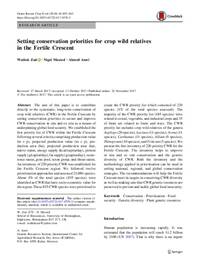Setting conservation priorities for crop wild relatives in the Fertile Crescent

Authors:
The aim of this paper is to contribute directly to the systematic, long-term conservation of crop wild relatives (CWR) in the Fertile Crescent by setting conservation priorities to secure and improve CWR conservation in situ and ex situ as a means of underpinning global food security. We established the first priority list of CWR within the Fertile Crescent following several criteria comprising production value (m × p), projected production value (m × p), production area (ha), projected production area (ha), native status, energy supply (kcal/capita/day), protein supply (g/capita/day), fat supply (g/capita/day), occurrence status, gene pool, taxon group, and threat status. An inventory of 220 priority CWR was established for the Fertile Crescent region. We followed twelve prioritisation approaches and assessed 21,080 species. About 4% of the total species (835 species) were identified as CWR that have socio-economic value for the region. These 835 CWR species were prioritised to create the CWR priority list which consisted of 220 species (1% of the total species assessed). The majority of the CWR priority list (185 species) were related to cereal, vegetable, and industrial crops and 35 of them are related to fruits and trees. The CWR priority list includes crop wild relatives of the genera Aegilops (20 species), Lactuca (11 species), Avena (11 species), Carthamus (11 species), Allium (9 species), Thinopyrum (10 species), and Triticum (3 species). We present the first inventory of 220 priority CWR for the Fertile Crescent. The inventory helps to improve in situ and ex situ conservation and the genetic diversity of CWR. Both the inventory and the methodology applied in prioritisation can be used in setting national, regional, and global conservation strategies. The recommendations will help the Fertile Crescent meet its targets in conserving CWR diversity as well as making sure that CWR genetic resources are preserved to prevent and tackle global food insecurity.
